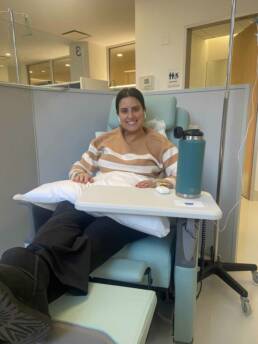I was diagnosed with Relapsing-remitting Multiple Sclerosis (RRMS) when I was 21 years old. RRMS is the most common type of Multiple Sclerosis (MS). MS is a ‘chronic, incurable, and unpredictable disease of the central nervous system (CNS) including the brain, optic nerves, and spinal cord.’ It presents itself very differently amongst patients and is hard to detect for that reason. To me, it’s an invisible disease because if you are not experiencing symptoms, a flare up, or episode, you may be able to look, feel, and operate as normal. This makes it difficult to not only diagnose but explain to loved ones, friends, and beyond. It also makes it difficult to uncover if it is causing feelings like fatigue, confusion, imbalance, high emotions, and more.

There was a period of about six months from the onset of my symptoms to an official MS diagnosis. It was a confusing time for me – I had been in college enjoying life with my best friends. I went home for break with my family and one day my left hand went entirely numb. I figured it would bounce back and just ‘fell asleep’ like our limbs sometimes do, but it perpetuated. It was hard to do my schoolwork using my computer, hard to explain to my parents, and my friends, and ultimately difficult to understand the best next step.
I went home and received an MRI where they detected some demyelination of my nerves on my spinal cord. This means that the protective barrier on my nerve cells in that area were destructed and therefore my nerves were exposed. This often leads to Multiple Sclerosis, but it was too soon to tell. Myelin is important because it works to augment the conduction of nervous signals and protect our nerves from disruptive invaders. I was frantic and scared because by then, my symptoms had progressed and presented themselves periodically. My episodes came and went a few times per day. It was focused on the left side of my body, so in addition to my numb hand, I would get shooting pains down my leg, numbness and tingles on my face and tongue, and slight loss of balance even when completing simple tasks like walking back from class.

About six months from the initial MRI, I was diagnosed with early onset MS. At diagnosis, when my first question was ‘what could have caused this?’, I was told that MS is caused by ‘environmental factors.’ So, the ambiguity of how or why left me disheartened as I was searching for answers. It broke my heart witnessing my parents go through this diagnosis that I would fight for my lifetime. I can’t imagine being a parent in that situation. That is why our caregivers are just as important as our patients, the impact is just as palpable.
From that day, I actively chose to not let my MS define me and instead chose to harness a strong and positive outlook on my future and take as best care of myself as possible. I worked to control the controllable. I addressed vital deficiencies I faced like a major lack of Vitamin D and B12, I ate foods that were proven to reduce inflammation and support your immune system, and I continued to exercise daily to keep peace of mind. But, ultimately, that wasn’t enough, and legions continued to appear on my MRI scans in new areas like my thoracic spine and my brain. I had to decipher a treatment path to ultimately mitigate the risk of becoming physically disabled in the future.

Now, there isn’t a cure for MS, but there are many preventative treatments that are proven to slow the progression of the disease. The first neurologist I saw recommended a treatment path which was a three-time weekly injectable medication. Needles don’t bother me, but that sounded high-maintenance and I had to assume there was a better way, so my family and I kept looking for the best specialist for me.
We all have different needs, fears, and anxieties, depending on our access, age, stage of life. It is important to be diligent in working with providers who understand us as individuals first above all. Once I found my present-day neurologist whom I trust with my life, I felt like I was in the best hands to tackle my future and be as symptom-free as possible. He immediately shut down the idea of the injectable medication because he didn’t think I’d be comfortable living with scars and marks from injection sites, especially as a young woman. I will never forget that he paid such attention to detail, and at the time those injectables were extremely popular. But his approach was to help me live the most disability-free life as possible and that also came with mitigating treatment burden. He knew that the less time I spent thinking about my disease, the more time I spent living my life. He suggested a bi-annual intravenous treatment where I come on site twice a year, infuse, and then go live my normal life.

When I joined Jumo Health I was able to make immediate parallels to my experience, because our goal here is to create the most trusted, relatable, and actionable resources possible so patients are empowered and educated in their clinical trial journey. I was looking for a doctor whom I could trust with my life, understood where I was in my journey, educated me, and helped me take the appropriate steps to be the best version of myself living with MS possible. It really proves the power of attention to detail.
Luckily for me, I haven’t experienced a physical episode or symptom in years, and I am fortunate enough to be able to dismiss that I am living with MS most days. But I know that there are others that are not as fortunate which is why we continue to raise money for research, raise awareness for patients, and strive for as many health equities as possible. We, as patients, all deserve the care we seek and that is why I am so passionate about being a part of the Jumo Health family to create awareness, access, and ultimately action for the empowerment and betterment of patients and their families.



